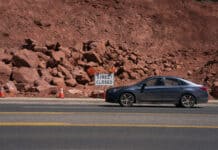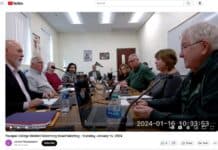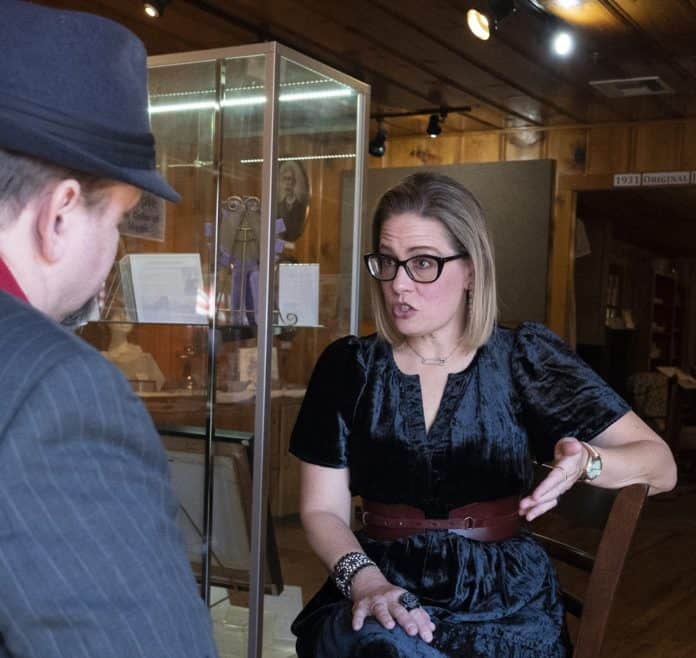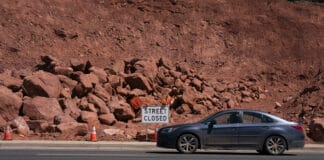U.S. Sen. Kyrsten Sinema [D-Ariz.] spoke Nov. 11, at the Veterans Day commemoration at the Sedona Heritage Museum. Afterwards, she met for a one-on-one interview.
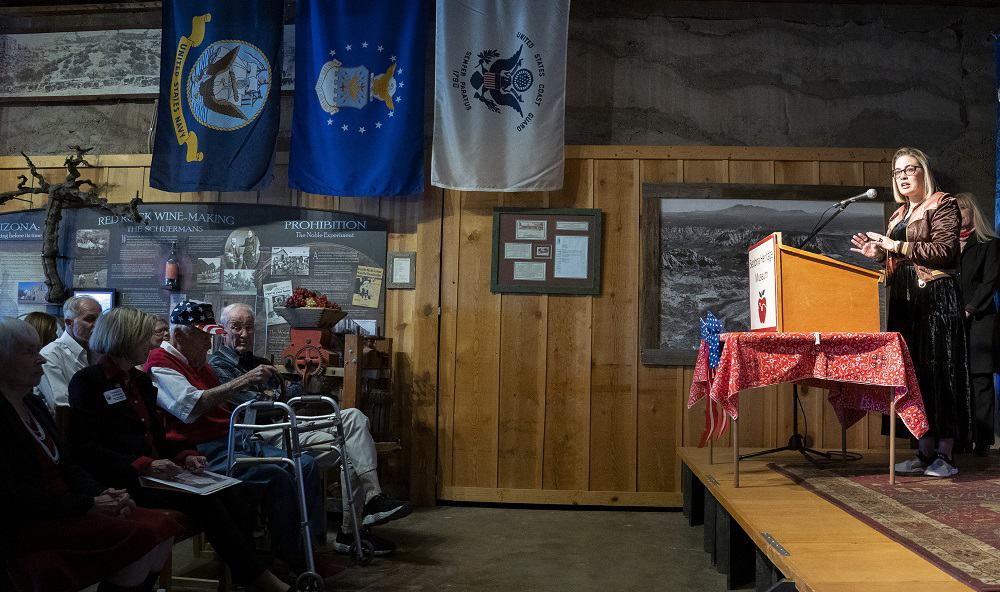
Sinema has come to national prominence for being one of two moderate Democratic senators sparing with progressive Democrats, which have delayed a vote on two major pieces of legislation in President Joe Biden’s agenda: The multi-trillion-dollar Build Back Better Act that contains numerous Democratic Party policy goals, and the $1.2 trillion Infrastructure Investment and Jobs Act, which was finally passed by Congress on Nov. 5, but was not set to be signed into law by Biden until Monday, Nov. 15.
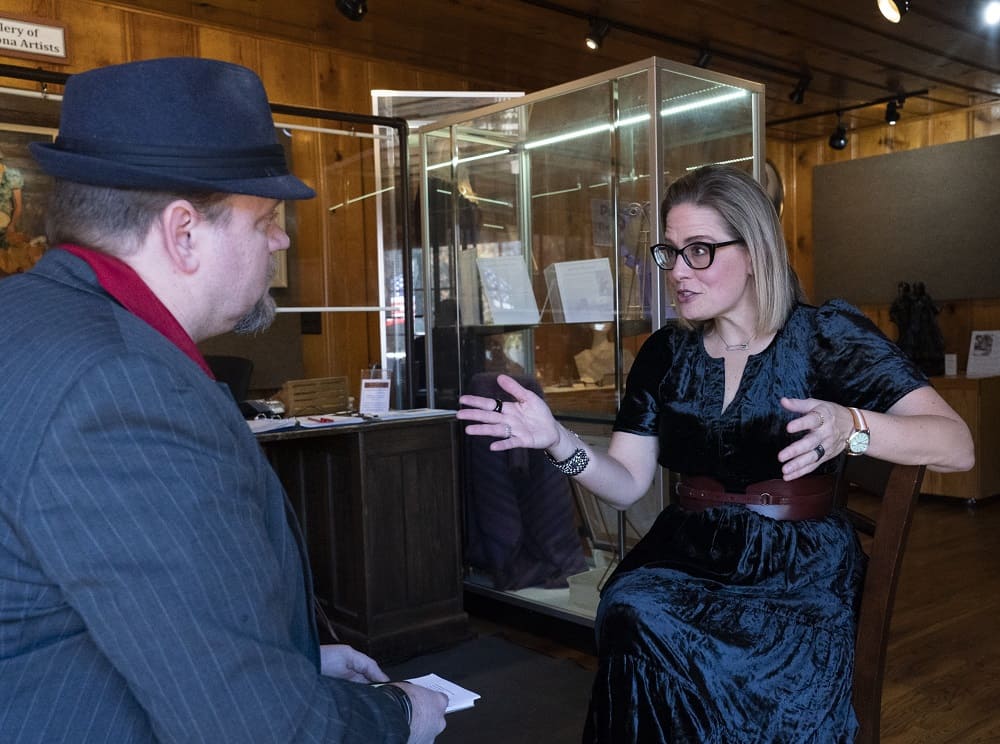
Infrastructure
Sinema addressed how the infrastructure bill affects Sedona and Northern Arizona.
“So one of the biggest impacts on Northern Arizona will be the relief that is provided for wildfire cleanup,” Sinema said. “As you know, we’ve had huge devastation and wildfires in Northern Arizona in recent years. And the infrastructure legislation creates $6.5 million just for cleanup of some of those burns scar areas like Mount Elden over in Flagstaff,” she said, referencing the 1,961-acre Museum Fire of 2019, “and of course some of that covers the whole 4FRI [Four Forest Restoration Initiative] area.”
“Another area that’s really important is the Western water storage,” Sinema said. “We got about $8 billion into Western water storage, which specifically addresses water shortages in the Western United States. So it’ll be a big impact for Northern Arizona.”
“Two other things that I think would be really important is that the bill creates specific legislation for road and highway repair, as well as bridge repair,” she said. “So for folks who are traveling between Sedona, Flagstaff, Prescott, Phoenix, etc., there will be dollars specifically slated for highway repair and bridge repair.”
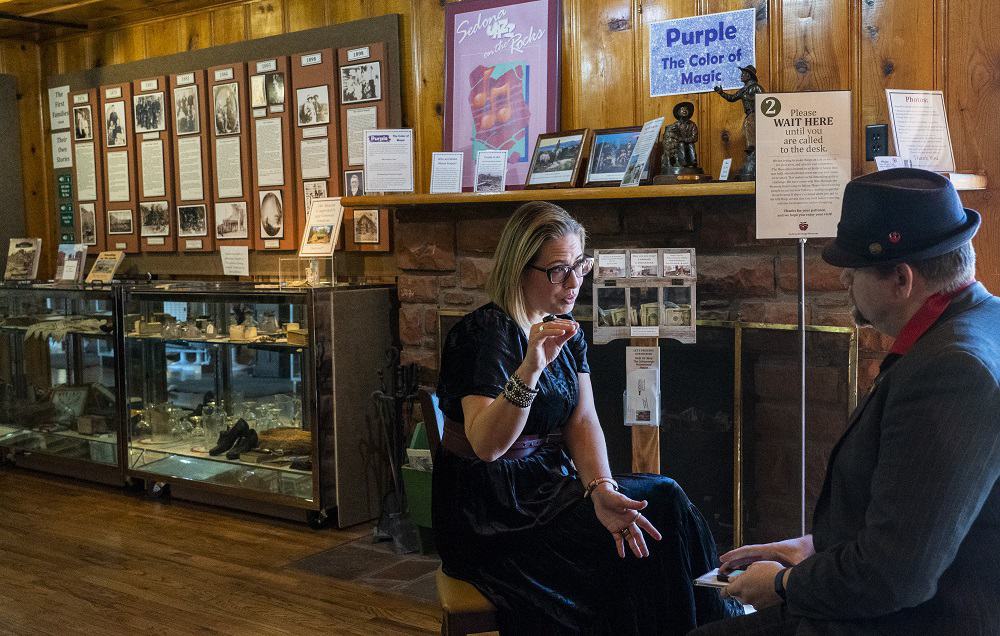
U.S. Sen. Kyrsten Sinema [D-Ariz.] speaks with Sedona Red Rock News Managing Editor Christopher Fox Graham at the Sedona Heritage Museum on Thursday, Nov. 11.
“One area that I think is important to folks who live in the Sedona community that may be outside the main city area would be broadband,” the senator said. “So we included $65 billion — that’s with a ‘B’ and it’s, I mean, it’s like crazy money, right? — to expand broadband to rural communities and that includes what we call ‘middle mile’ and ‘last mile.’”
“Right now, a private company will do broadband in an area where it’s financially feasible, so they’re going to make some money, and they’re going to put broadband in the town,” Sinema said. “But as you get out into the rural communities, you lose those cell towers, you lose your opportunity for broadband underground, and it’s because it’s just not profitable.
“So our infrastructure bill has enough funding to put broadband all the way through the country, including into the bottom of the Grand Canyon for the Havasupai Tribe, all the way out to rural areas on the outskirts outside of the city limits of Sedona. So it’s a big deal for rural communities.”
“I could go on for a long time, but those are some examples,” she said.
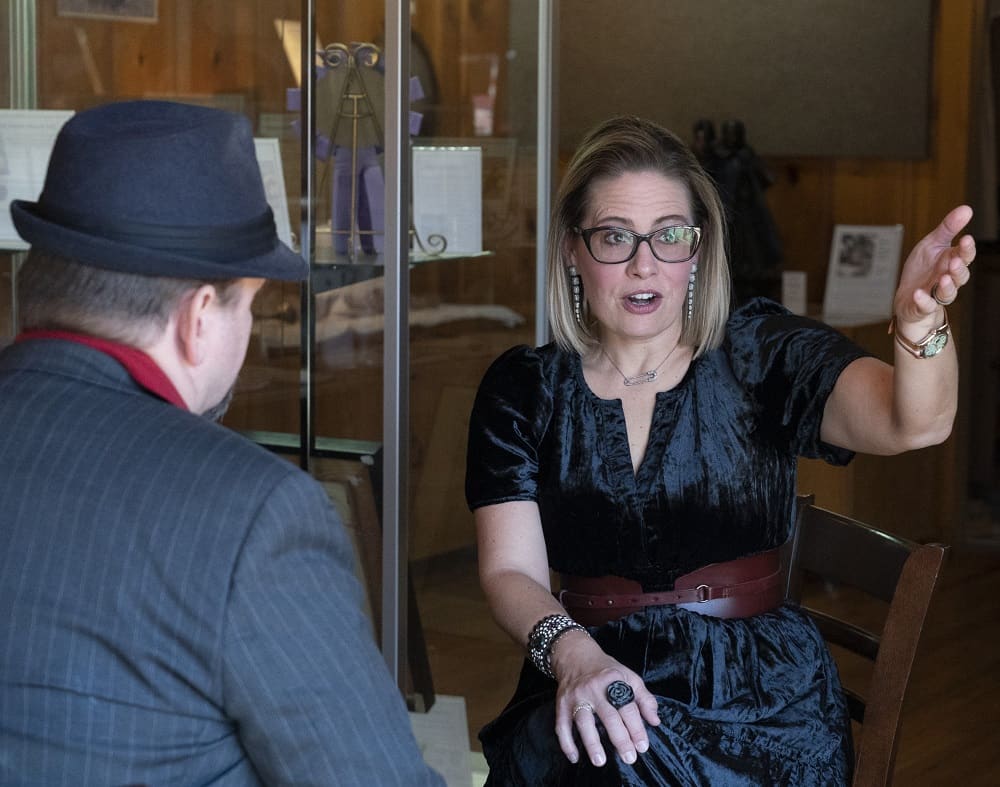
Repealing the Filibuster
Sinema has come under fire from activists for her opposition to repealing the filibuster, a senate rule that allows senators to speak on any topic and effectively delay votes unless three-fifths of the senators vote for cloture to end debate. The filibuster was drafted in 1806, but not used until 1837. After 1970, filibuster rules were strengthened and senators of both parties use the filibuster or the threat thereof to halt votes by the majority.
Regarding Sinema’s opposition to repealing the filibuster, she said, “So the first two years I served in the United States Senate, I served in the minority party. And we used to filibuster on a very regular basis to stop the majority party from enacting legislation that we believe was not right for our country. Everyone on the left agreed with it at that time.”
“Now that my party is in the majority, there’s a lot of agitation and requests to eliminate the filibuster,” Sinema said. “But what I think is important to remember is that the filibuster is a tool. It doesn’t have a positive or negative connotation. It’s just a tool. But it is a tool to protect the rights of the minority party. And whether you’re in the minority or the majority, remembering that the shoe can fit the other foot is really important.”
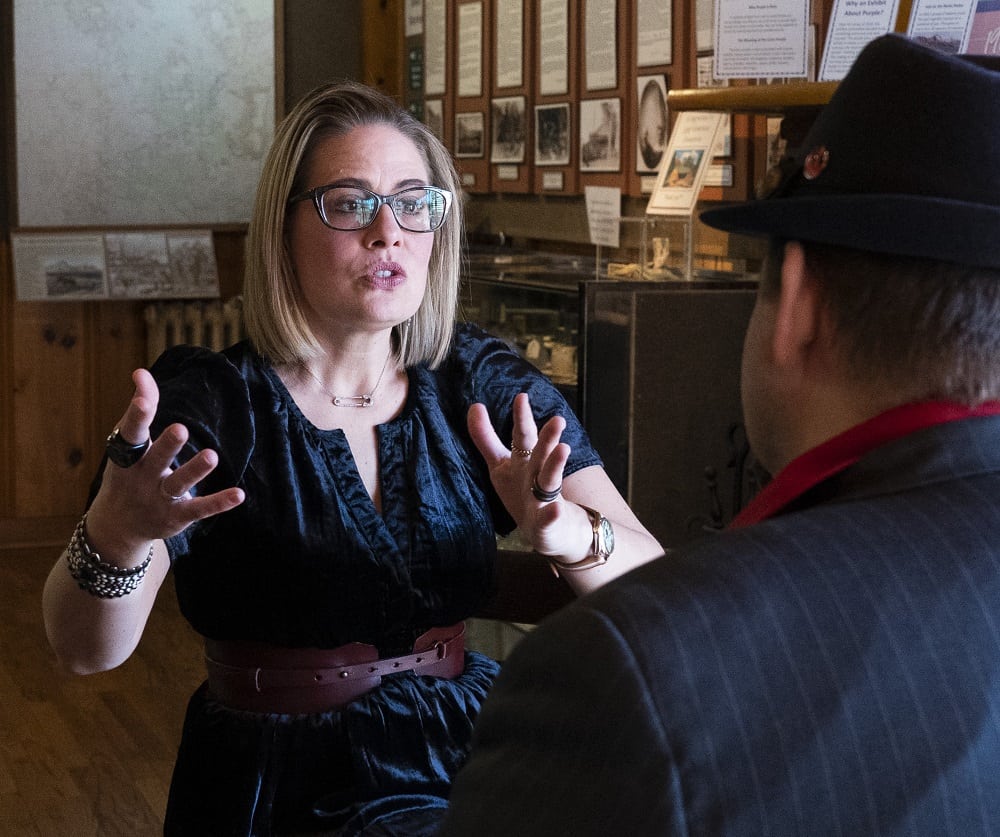
“Right now, there are folks who say we should get rid of the filibuster because we’re in the majority,” the senator said. “But the tables will turn again, the tide will turn again. And there will come a time when those very folks who want to get rid of the filibuster will call the office and say, ‘Kyrsten, you’ve got to protect the filibuster, because we can’t have X happen or Y happen.”
“I wrote an op-ed in The Washington Post a number of months ago,” she said [“Kyrsten We have more to lose than gain by ending the filibuster,” June 21], “because I wanted people to understand the stakes and how high they are.”
“If you were to get rid of the filibuster for a couple of short-term pieces of policy, there could come a time where the other party was back in control,” she said. “And maybe there was an attempt to remove a woman’s right to make decisions about her health or her body. Maybe there would be an attempt to eliminate the Environmental Protection Agency, which keeps our water and our air clean so we can enjoy Sedona, maybe there would be an attempt to get rid of all rights for workers to organize.”
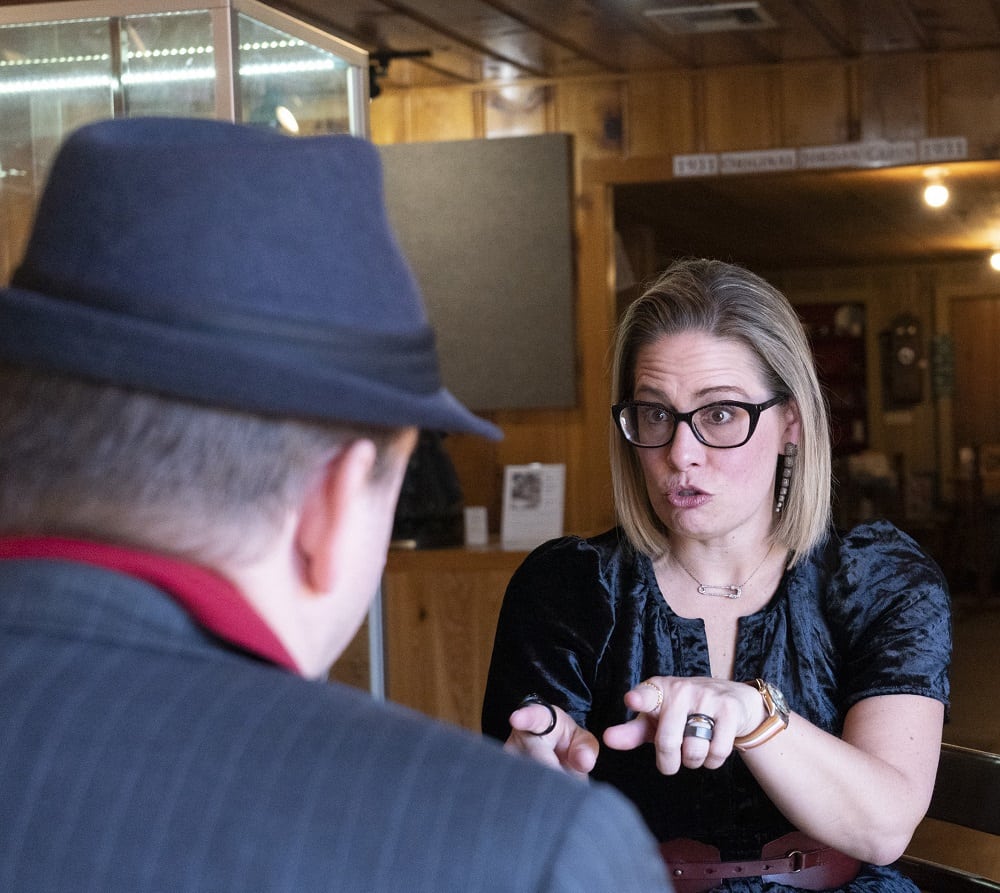
“So the risks associated with this are, in my opinion, even more heightened than the short-term benefits that would come with eliminating this protection,” Sinema said. “Our forefathers were pretty smart when they thought of this. And they thought of it to say we don’t want any one party to go too excessively to the right or to the left. We want to keep that equilibrium in the middle.”
“Everyday people don’t get up and think to themselves, ‘you got to keep or eliminate the filibuster,’” Sinema said. “Everyday people get up and think, ‘I hope my kids can go to college; I hope I can pay my mortgage, hope my kids will be able to buy a car — they think about regular things. And I think what they’re looking for from their elected officials is to protect those regular everyday policies.”
“The filibuster is just a tool to protect that equilibrium of those regular everyday policies,” she concluded.
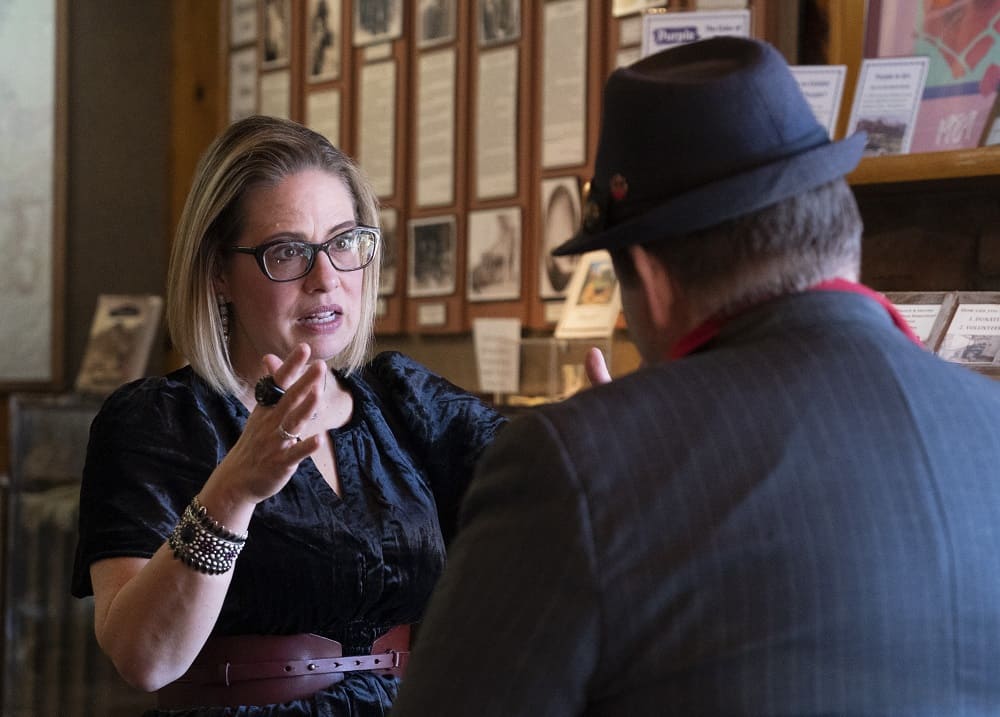
Local Journalism Sustainability Act
The Local Journalism Sustainability Act as it now stands would provide tax credits, allowing readers to offset 80% of news subscription costs in the first year and 50% in the subsequent four years, up to $250; offer a tax credit up to $5,000 for small businesses to buy ads in local publications; provide payroll tax credit for hiring news reporters, editors, photojournalists and support staff at 50% for the first year and 30% the second year.
“It’s moving forward in the legislation; we’re feeling good about it,” Sinema said. “As everyone knows, now that we’ve passed the bipartisan infrastructure plan, which I’m incredibly proud of … we’ll now turn our attention to continuing to negotiate and complete the Build Back Better Act, which is like the second part of Biden’s agenda and the [Local] Journalism Sustainability Act as part of that legislation.”
“I anticipate it will continue to move forward,” she said. “But we do have a number of weeks ahead of us of kind of working out the rough edges of that legislation as we move forward.”
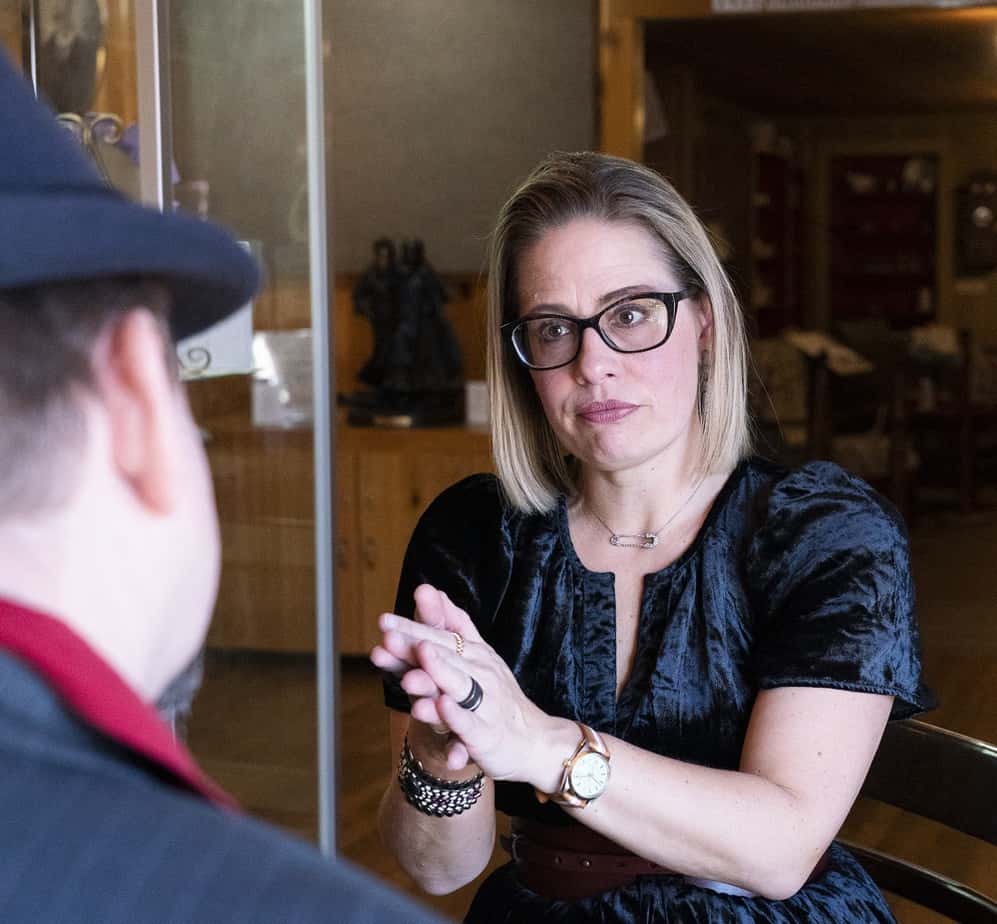
Pharmaceutical Lobbying
Last week, Sedona residents got several mailers from Center Forward political action committee urging voters to call Sinema and thank her and “tell her to keep being an independent and effective leader for us.”
Center Forward claims it wants to find bipartisan common ground drug policy and other issues. According to tax filings reported in Kaiser Health News in 2016, Center Forward received $300,000 directly from the Pharmaceutical Research & Manufacturers of America and another $179,000 from the Campaign for Medical Discovery, a PhRMA-backed group. In the 2018 election cycle, Center Forward spent $1.3 million on Democratic candidates with $1.19 million in donations coming from PhRMA, a group that both lobbied against the Affordable Care Act in 2010 and heavily lobbies against Medicare for All and single-payer legislation.
Over 10 years in Congress, Sinema received $519,988 from the pharmaceutical industry, related groups and individuals, including $73,530 in 2020 even though she’s not up for reelection until 2024.
Sinema said she has no influence over what third-party political groups mail out, “because that would be illegal.”
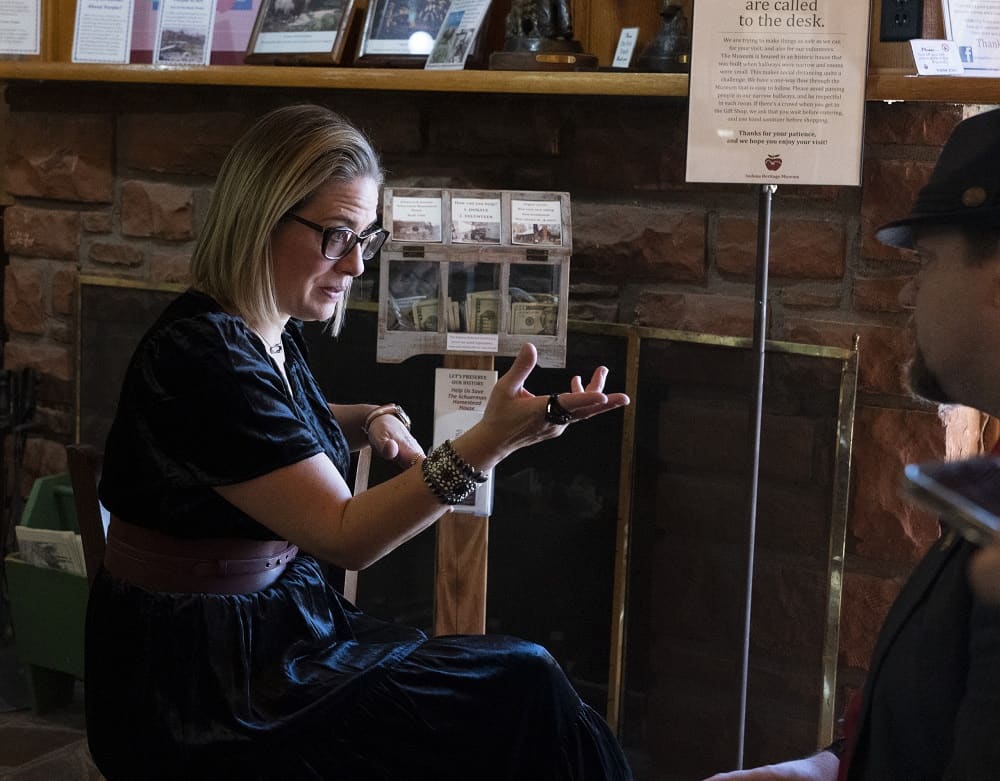
The question posed is with Sedona’s population demographically leaning older, how can seniors trust Sinema to be independent in Medicare and prescription drug negotiations, considering lobbying efforts by Center Forward and PhRMA groups?
“That’s a great question. When I ran for Senate in 2018, I pledged to try and work to have prescription drugs be available at the lowest cost possible for seniors,” she said. “So throughout this process that I’ve been negotiating on this drug pricing negotiation package — which we achieved, I’m very proud of it — my goal was to make sure that we were having prescription drugs available at the lowest prices to seniors, and it took a while, took a few months, but that’s normal in the legislative process.
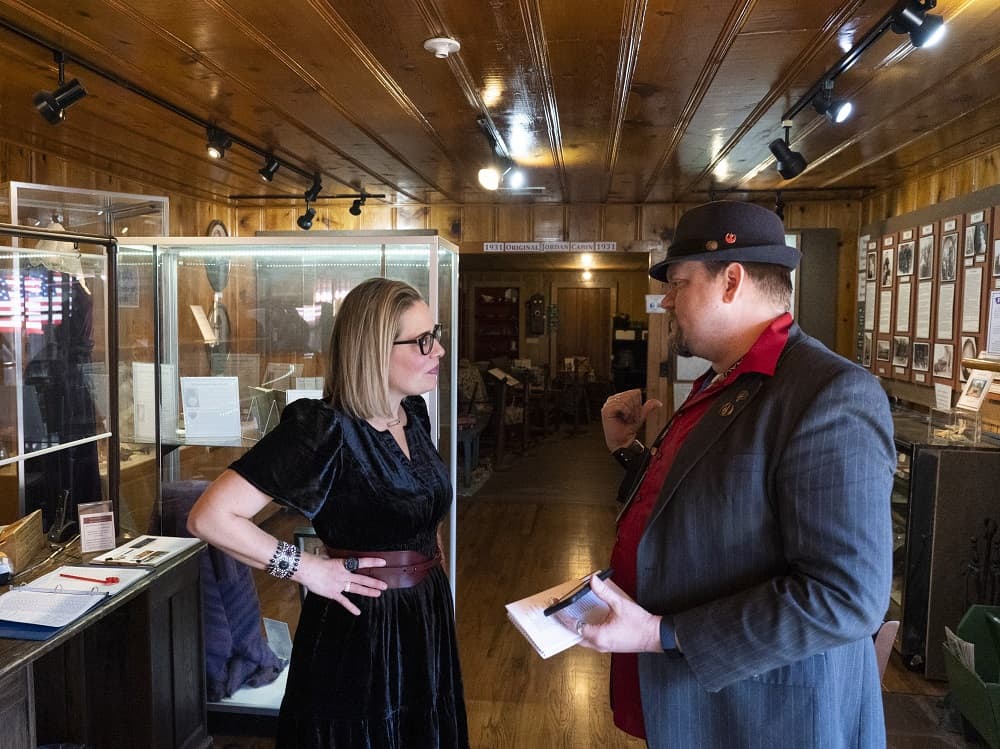
“I’m really proud to report that Speaker [of the House Nancy] Pelosi and I did come to an agreement and we will make an out-of-pocket cap for seniors: $2,000 a year is the most that a senior will pay for his or her drugs out of Part B and Part D.”
“Part D is where you get your drugs over at the pharmacy, and part B is the specialty drugs you’d get from a doctor like chemo medicine.”
“Part B is very expensive, but Part D is bigger,” she said. “So we agreed to negotiate on both of those to lower costs so that no senior pays more than $2,000 a year, out of pocket.
“That’s a huge deal and we kept insulin at $35 a month,” she added.
“It’s in the Build Back Better proposal,” Sinema said. “So the Build Back Better bill is still being negotiated, but that part is done.
“So we’ve solved that part and it’s good and I’m really happy with it, because it does what I’ve pledged which is to give prescription drugs at the lowest cost possible seniors, and achieves our shared goal of ensuring that seniors aren’t paying more out of pocket than they can afford,” Sinema said. “So no longer will seniors have to choose between buying food or buying their prescription drugs. So it’s a great outcome.”
Regarding the PhRMA lobbying, Sinema added, “No, what I can’t do is speak to what an outside group is doing because I have no idea. What I can do is say that I’m very proud of this agreement.”
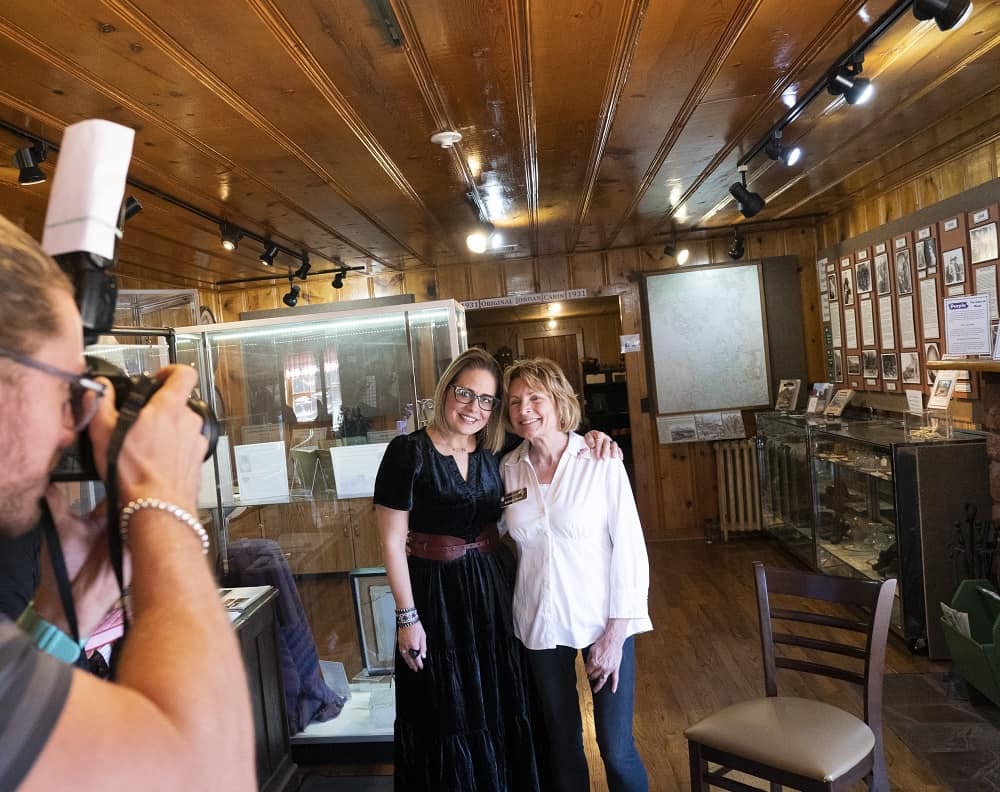
Contact Sinema
For constituents who want to contact Sinema or her office, she said her website sinema.senate.gov is the best method.
“Our casework team responds within like a day, so they get back really quickly,” she said. “Email is the fastest, although there are some people who don’t have good access to the internet. They can certainly call the Phoenix office, and we’ll get back with them within 24 hours.”
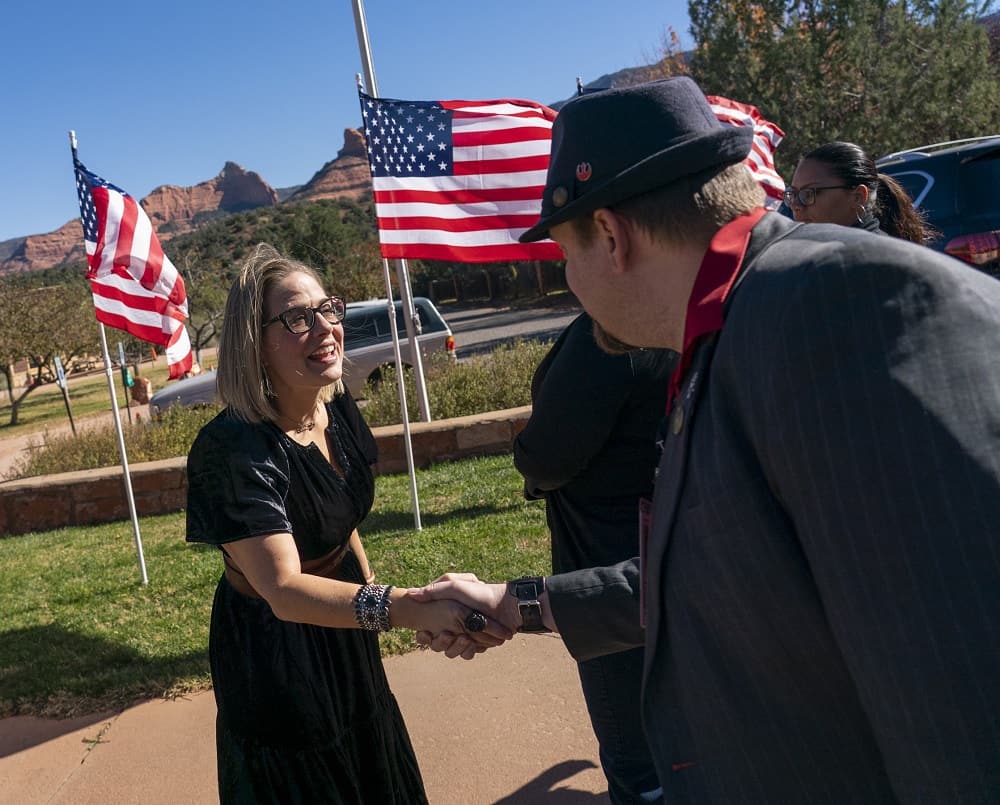
The Infrastructure Investment and Jobs Act includes:
- Better roads & bridges: A $110 billion investment to repair and upgrade America’s roads, bridges and other major transportation projects including the largest investment in bridge construction and upgrades since the construction of the interstate highway system.
- Expanded broadband: $65 billion to deploy high-speed broadband, expand broadband internet access and help families afford broadband service.
- Water systems: The largest investment in clean drinking water and wastewater infrastructure in U.S. history and more than $8 billion to strengthen water infrastructure in the American West, such as aging infrastructure, water storage, water recycling, drought contingency plans and dam safety, including $300 million for water reclamation operations under the Colorado River Drought Contingency Plan with $250 million of that for the Bureau of Reclamation to create or conserve 100,000 acre feet of water annually for the Lower Colorado River Basin at Lake Mead.
- Power grids: $65 billion to strengthen electricity grids around the country and promote resilience of power infrastructure, creating a new Grid Development Authority to build a clean energy, a 21st century electric grid, and investments in clean energy sources like hydrogen, nuclear and carbon capture, utilization and storage.
- Wildfire suppression: $8.25 billion to protect wildfires, support wildfire recovery and reduce hazardous fuels on federal, state and tribal lands.
- Tribe: $3.5 billion for tribal water and sanitation infrastructure and resiliency, $2 billion to expand high-speed broadband in tribal communities and $2.5 billion in funding to complete currently-authorized Indian Water Rights Settlements including building out the infrastructure for the Southern Arizona Indian Water Rights Settlement with the Tohono O’odham Nation, completing the Gila River Indian Community Water Rights Settlement, and funding the White Mountain Apache Tribe’s Water Rights Settlement.
- Airports: $25 billion to repair and upgrade airport terminals, runways, taxiways and air traffic control towers.
- Public transit & Rail: $39.2 billion to expand transit systems, increase accessibility and fund the nation’s transit system repair backlog of more than 24,000 buses, 5,000 rail cars, 200 stations, and thousands of miles of track, signals and power systems — the biggest investment in passenger rail since the creation of Amtrak, with $66 billion to improve existing routes and expand to new cities.
- Clean energy: The largest investment in clean energy transmission and electric vehicle infrastructure in U.S. history, electrifying school and transit buses across the country, bolstering critical materials supply chains, improving energy efficiency and building out a national network of electric vehicle charging infrastructure.
“From better roads and more reliable power grids, to faster internet in more corners of our state, to safer airports and cleaner water — everyday families in Arizona and across the country will see big benefits from our bipartisan Infrastructure Investment and Jobs Act,” Sinema stated in a press release issued after passage of the bill. “It’s easy for politicians to stay in their partisan corners. I promised Arizonans something different — that I would work with anyone to get lasting results for our state. I’m incredibly proud to have co-led this bill to create jobs and expand economic opportunity in communities across America, and I look forward to it becoming law.”
Click to watch Sinema’s comments at the Infrastructure bill signing ceremony
https://www.c-span.org/video/standalone/?c4986846/user-clip-infrastructure-bill-signing




